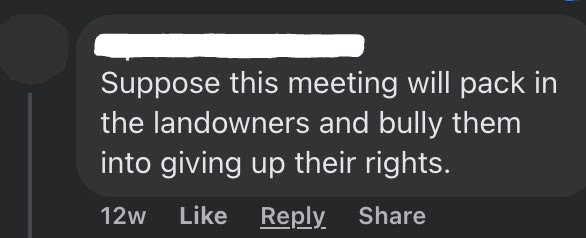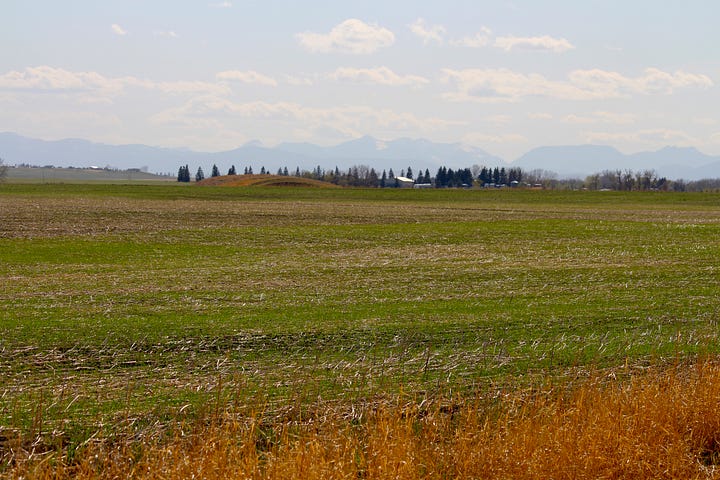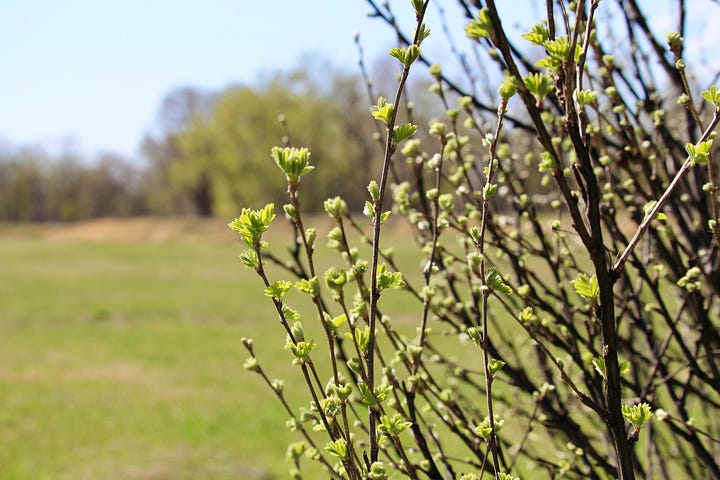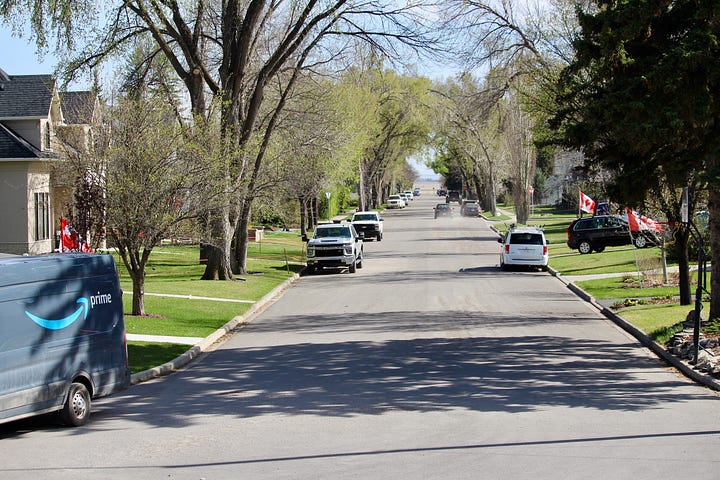UNLOCKED: Behind-the-scenes of The Missive #15
Polluter pay principles under pressure, memories of R-Star, and calming High River photos at the end for paid subscribers (also, a special MOM STRONG deal!)
My Scottish/Irish ancestors were immigrants who travelled by ship to the east coast of so-called “Canada” in the late 1700’s or early 1800’s and were part of several waves of genocidal colonization of the Indigenous people on Turtle Island. We arrived uninvited on the traditional unceded territory of the Wəlastəkewiyik (Maliseet) whose ancestors along with the Mi’Kmaq / Mi’kmaw and Passamaquoddy / Peskotomuhkati Tribes / Nations signed Peace and Friendship Treaties with the British Crown in the 1700s. As a child in the 1970’s, my parents moved west to work in the oil sands industry and I grew up in the Nistawâyâw (Cree) Ełídlį Kuę́ (Dene) - Fort McMurray area within Treaty 8 territory, which his home to six First Nations and six Métis communities. Today, I am grateful to be writing this newsletter from Moh’kinsstis, and the traditional Treaty 7 territory of the Blackfoot confederacy: Siksika, Kainai, Piikani, as well as the Îyâxe Nakoda and Tsuut’ina nations. This territory is also home to the Métis Nation of Alberta, Region 3 within the historical Northwest Métis homeland. I recognize that the land I now work and live on was stolen from these Nations (truth) and I support giving the land back as an act of reconciliation. Lands inhabited by Indigenous Peoples contain 80% of the world’s remaining biodiversity. Indigenous Peoples’ traditional knowledge and knowledge systems are key to designing a sustainable future for all. We are all Treaty people on Native land.
Thoughts following my latest article in The Energy Mix:
MAY 28, 2025 UPDATE: I’m fully unlocking this post that was originally for paid subscribers since there is more news coming out about Alberta’s orphan wells and I thought you might like to have a bit more background on the problem.
I’ve been away from social media and my freelance reporting for a few weeks. I was helping my 80-year-old mom through hip replacement surgery here in Calgary. More details on that for my paid subscribers at the end of this post!
If you have the ability to become a paid subscriber to The Missive, I’m offering a special “Mom Strong” discount for annual paid subscriptions in honour of my mom, who came through the surgery with flying colours and is doing great. She’s inspiring me to get back out there and fight the good fight.
Gratitude to those who continue to help me financially so I can do what I love in my semi-retirement. If you are unable to pay, don’t sweat it, my main newsletter is free and will always remain that way. My behind-the-scenes posts just offer a little extra background for those who may want to dig a little deeper. I also get a little more personal with other observations and share more about other projects I’m working on. I also share photos you won’t see anywhere else…or at least you’ll see them before anyone else does.
In early April, the Alberta government released what it called a “Mature Assets Strategy.” An earlier draft version of the strategy had been leaked to The Canadian Press a few weeks beforehand and reportedly, suggested the cleanup of abandoned oil and gas wells would be “backstopped by public funds.”
Brian Jean, Alberta’s Energy Minister quickly went on the defensive telling reporters, “we will not put public tax dollars into cleaning up wells.”
When the updated report came out, the reaction was immediately negative.
The Rural Municipalities of Alberta (RMA) put out an official statement the next day expressing their disappointment with the headline “Flawed process leads to flawed outcomes.”
While supportive of the need for a strategy, RMA President Kara Westerlund said, “Unfortunately, what RMA has witnessed throughout the Mature Asset Strategy process and in the final report is a narrow focus on keeping companies and wells profitable at any cost to other stakeholders, with no corresponding industry accountability, or consideration of impacts on everyone else.”
Both the RMA and individual landowners posting on the Alberta Surface Rights Federation’s Facebook pages expressed cynicism about the motives behind the strategy, which was authored by an oil and gas industry insider, David Yager.


Yager is a friend of Danielle Smith’s, and The Tyee has reported he “has received at least four sole-source contracts totalling nearly $500,000, two from the executive or cabinet, which the premier heads, including a current contract that runs until February.” A third contract for “professional services” is from Alberta Energy.
The environmental law charity, Ecojustice, warned in a statement that the government-sponsored report was “trying to push Alberta to shift the clean-up cost and burden away from industry.”
Susanne Calabrese, managing lawyer of Ecojustice’s Alberta office said public funds should be used for essential services, and the report “hides whether public funds will be used instead to pay for the clean-up of billions of dollars in environmental harms — that industry is already legally obligated to pay for and has profited from.”
The Coalition for Responsible Energy emailed out a statement to the media calling for the report to be “tossed in the trash.”
Spokesperson Phillip Meintzer said “Albertans should be concerned about the lack of transparency and limited stakeholder consultation in this process, run by oil and gas representatives for the benefit of oil and gas companies.”
“The Alberta Health Services scandal shows what comes from backroom deals and closed-door processes like this one. It’s another Danielle Smith scheme to let the polluters walk away, while we all pay,” he said in the statement. I interviewed Meintzer and will cover more of what he said later in this post.
With all of this in mind and having recently read an investigative piece in ProPublica about how fossil fuel companies in the United States (US) have been avoiding oil and gas well clean-up for decades, I decided to dive into the 52-page Mature Assets Strategy document to decide for myself.
With some help untangling the report from editor Farida Hussain, here’s an excerpt of the final story, and at the end is a link to read the full article on The Energy Mix website.
To read further insights from this story, I’ve got more information following the excerpt below for paid subscribers, but be forewarned, it is not good news for Alberta taxpayers.
Alberta Follows Familiar Playbook to Help Fossils Sidestep Well Cleanup Obligations
Critics warn that taxpayers and local communities could be on the hook for cleaning up a growing inventory of abandoned oil wells and fossil fuel infrastructure in Alberta under a new “mature assets” strategy proposed by industry veteran David Yager.
The report, published in April, reflects a well-known pattern the industry has used for decades to avoid responsibility for clean-up costs.
Yager’s report acknowledges the scale of the problem: the province houses more than 270,000 wellbores that are barely profitable, inactive, or decommissioned—with reclamation not yet complete. In addition, about half of the 38,000 production facilities built by the industry are inactive or decommissioned, but not reclaimed. And about 40% of the 440,000 kilometres of pipelines criss-crossing the province are decommissioned or not operating.
This aging infrastructure hasn’t been properly cleaned up and poses environmental and financial risks—yet industry players have so far largely avoided the full cost of closure. Yager’s advice, now being reviewed by the province, on how to deal with these “mature assets” align with industry interests: extract more value from old wells and extend their life, speed up reclamation by adopting “flexible regulatory frameworks,” breathe “new life” into a challenged sector with higher gas prices that reflect well closure costs, and introduce asset insurance that could be managed by the province.
Some of these strategies are part of a well-documented “playbook” used by oil and gas producers in the Permian Basin, reported ProPublica in December.
Oil and gas producers—having received generous government subsidies and tax breaks to pump oil profitably—sidestep their cleanup obligations through asset transfers and legal loopholes.
As oil companies operating in Canada post record earnings, Yager writes this “apparent profitability” is a cause of growing public concern over the pace of well closures. His own picture of the oil industry is bleak—it is beleaguered by a growing inventory of failing assets, collapsing gas prices, limited access to capital, increasing costs from carbon taxes, and regulatory complexity.
He also blames public investment in low-carbon energy and “widespread belief that oil and gas resources are an existential environmental threat.”
Read the full article for FREE on The Energy Mix website.
Dear family, friends and supporters,
Before diving back into the Mature Assets Strategy, I thought I’d give you a bit more on my family’s own “mature asset” – my mom!
So far - the surgery we were told would be life changing, has definitely lived up to the hype. After having both knees replaced, it became clear that it was Mom’s hip that was holding her mobility back. The surgeon, Dr. Rajrishi Sharma, took one look at the x-rays and told us her hip was at the point of collapse. She was rushed to the top of the priority list and qualified for a new surgical approach called a direct anterior total hip replacement.
The surgery, which is relatively new to Alberta, has a quicker recovery time by avoiding detaching tendons and cutting through muscles. It’s a remarkable operation and Mom was able to come home after only one night in the hospital. She walked with assistance quite a distance from my car to her suite at Medicine Tree the day after her surgery. It was astonishing!
Now, almost three weeks later, she is well on her way to recovery with a goal of not needing a walker at all in another three weeks. She has been relying on a walker for about six years now, experiencing a lot of pain almost all the time. This surgery has improved her quality of life significantly, as was promised.
As for our experience with the health care system in Alberta, despite the chaos being foisted on front-line staff, they continue to deliver pretty good results. There is a noticeable difference in the communication with patients since her last surgeries, which now seem much more disjointed (no pun intended). The disconnection between her family doctor, the surgeon, the lab, the hospital, and local home care was evident.
This will probably only worsen under the UCP’s strategy of breaking up Alberta Health Services into four different groups under different cabinet ministers.
We now have FOUR cabinet ministers responsible for the health portfolio. David Climenhaga wrote an opinion piece in The Tyee that goes into the possible reasons why almost 60% of Danielle Smith’s caucus now have cabinet positions.
He calls them “the four horsepersons of the health-care apocalypse.”
As some of you may know, I worked in communications for the Calgary Health Region back in 2005. It was a long time ago, but I learned a lot about the politics of health care during my brief time there. I started as a consultant writing/editing Calgary’s first ever pandemic preparedness plan, and once that was nearing completion, I accepted a full-time managerial position, supposedly to revamp the CHR website.
This was near the end of the Klein era, and the corruption I saw in senior officials associated with the Progressive Conservative party changed my outlook forever. The website project was never approved to proceed as the party scrambled to move forward under new political leadership and the health region management directed their attention elsewhere. The health care system today probably struggles under many of the same issues it did 20 years ago — political interference, corruption, and a lack of respect for front line professionals.
In Alberta, this is not only a problem in health care, but across multiple departments, including Environment and Protected Areas and the Alberta Energy Regulator.
Read my previous article in The Energy Mix about the newly appointed CEO of the Alberta Energy Regulator. He’s the former CEO of Strathcona Resources, a company with hundreds of inactive wells.
Which brings me back to the other “mature assets,” the thousands, actually hundreds of thousands, of oil and gas wells across the province that are barely profitable, inactive or decommissioned. They need to be properly retired and cleaned up. But is the premier listening to all perspectives? I fear not, after reading through the report and Yager’s 21 recommendations.
Despite stating the obvious, that “trust has been broken” between the province, industry, landowners, and municipalities, the report offers no real solutions to reset that relationship. In fact, based on the reaction to the report, it may have made things worse.
There’s no mention of how landowners are coping with the problems created by abandoned wells, or how they are impacted by companies not paying for accessing private land. The report repeatedly references the “hardships” of industry in meeting their legal obligations.
In her interview on YouTube with the Cross Border Network’s Municipal Affairs show, the RMA’s Westerlund said, “I'm going to be brutally honest, you know at the end of the day we know we're not going to recover the majority of that money we know that a large portion of that owing to municipalities is by insolvent and bankrupt companies.”
She said, however, there is “a hundred million is owed by companies that continue to operate” and she’s clear about what needs to be done. There is very little in the strategy about it, but Westerlund said she asked the energy and the municipal affairs ministers about whether these same companies are not making their royalty payments.
“Obviously, there is a mechanism in place if they’re not paying their royalties, which they confirmed,” she said. “We need to focus on the unpaid oil and gas taxes and look at the legislative issues and the gaps within regulations to stop this from continuing.”
Or as Phillip Meintzer put it succinctly in my interview with him, “it’s not like money hasn’t been made at some point off of these assets and that (the bankruptcy) is used to portray or tell this sad story, but that just covers up the fact that money was made from these things at some point.”
“We're going to have to get those off the landscape somehow. they need to be cleaned up, especially ones that are on people's land and if we don't do a good job of collecting the money to do that or forcing the companies to do that before they go bankrupt and offload the liabilities, then the problem just remains.”
It’s also not a problem unique to Alberta. It was estimated in 2021 that the cost for the government to clean up oil and gas wells in the 15 oil-producing American states was about $150 billion since companies have set aside less than 2% of the amount needed.
“It is the inevitable consequence of an entire regulatory program that is more red carpet than red tape,” said Megan Milliken Biven, founder of True Transition, a non-profit advocacy group for oil workers in the US.
This is what led ProPublica to write several investigative pieces about the pattern of behaviour of fossil fuel companies across North America. And Grist also wrote an excellent analysis of the problem, calling the Permian Basin “ground-zero for a billion-dollar surge of zombie oil wells.”
“When Laura Briggs and her husband finally found their dream home in West Texas, they knew they’d be sharing space with the oil industry. The Pecos County ranch’s previous owner, local attorney Windel “Hoot” Gibson, died there when a rickety old pumpjack teetered over and fell on top of him.”
Waves of Abandonment, Grist
Also noticeably absent from Yager’s report is a balanced representation of the challenges faced by municipalities when companies don’t pay the taxes they owe. Or the hardships faced by landowners. There’s barely anything mentioned about Indigenous people, who often live right next door to some of the most problematic infrastructure and environmental liabilities.
It’s no wonder the RMA responded as it did. Of the 11 goals of the strategy, only one addresses non-industry stakeholders. The expanded definition of a “mature asset” calls into question the government’s commitment to actually close and clean up the wells. The new working definition includes marginal or declining wells, which seems like a large red flag for what is really going on here.
A large portion of the document is absorbed with the many ways to keep those assets producing in support of Smith’s emphasis on “doubling oil and gas production.” Rather than a strategy to deal with the actual problem of these wells, pipelines and other infrastructure, it seems more like a not-so-clever rebranding of an actual problem into an asset that just needs to be further exploited.
Did Yager not understand the assignment? Or was the assignment really about this all along? This is how trust is further eroded.
Lawyer Drew Yewchuk said in an interview with Energi Media’s Markham Hislop that the mature asset strategy is another version of the R-Star proposal Smith lobbied for on behalf of the industry. She initially tried to carry the idea forward when she became leader of the UCP, which landed her briefly as an unelected premier before she called an election six months later.
“It’s a program near and dear to my heart.”
Danielle Smith
Under the R-Star banner, companies could earn some pretty lucrative credits on their royalty payments by cleaning up their messes…which they were already legally obligated to do. Andrew Leach explained that because royalties increase with oil prices, R-Star does little for producers when prices are low, but offers big rewards when prices and profits are high. And it carries a massive, unnecessary cost to Albertans.
“It’s a free lunch. Or, more properly, a lunch paid for by Albertans. It’s a wealth transfer to the oil and gas industry. Instead of ensuring the polluter pays, R-Star would have us paying the polluter,” said Leach.
The outcry both from within the UCP and externally was so loud that it was immediately scuttled.
The mature assets strategy proposes another incentive scheme, where companies are encouraged to keep their wells running as long as possible under the guise of “enhanced oil recovery.” When the companies want to offload the wells, the provincial government would take over responsibility for them under an entity called “HarvestCo,” and collect any income generated to put it towards the cleanup under another entity called “ClosureCo.”
Wouldn’t companies themselves do this if it were profitable? There has got to be a reason why they’re not doing it and I suspect it’s because the numbers don’t add up. What is being suggested here is that we - the taxpayers - “backstop” the assets in their dying days. Brian Jean may deny it, but I don’t see how you can interpret this any other way.
All of the risks are proposed to be taken on by the taxpayers and the companies would be once again OFF THE HOOK. There are no numbers provided to calculate the costs, but if oil prices continue this downward trend, I’d assume squeezing out a small bit of production would be a net loss for both HarvestCo and ClosureCo as far as paying for cleanup costs.
Even the managing director of Skye Asset Retirement, Lindy Couillard, seemed unsure whether the model her company is operating under already could be scaled up to the required level. Skye is a “ClosureCo” cleaning up about 20 wells for a well-funded international company as part of a pilot.
Without guarantees of public money, Couillard told the Globe and Mail in March it would be hard for companies to front the costs.
This version of the strategy is about 20 pages less than the draft version that was leaked, and many of the details around the creation of these two entities are not included. Meintzer pointed out in his earlier statement that additional financial support could be used to “accelerate closure,” but the report doesn’t state where that money would come from if not from taxpayers.
The report also recommends the creation of a post-reclamation environmental liability insurance fund, financed by licensees but “managed by the province,” which is still a use of public funds in the form of administrative support.
“We keep getting hits to public services, like cuts to education, cuts to healthcare, but there seems to be endless new ways to find avenues to keep these companies afloat,” said Meintzer.
Yager expresses disdain for regulatory requirements around cleanup, calling them “an unfair burden on industry with little benefit to the environment.”
“Some of the most stringent closure requirements – particularly those related to methane leak mitigation (e.g., Surface Casing Vent Flows) and soil contamination (e.g., salt in the soil) – often result in diminishing returns in terms of environmental protection, while simultaneously driving up costs for operators and leading to unknown and/or uncertain outcomes.”
David Yager
The Coalition for Responsible Energy is also concerned that “risk-based closure,” which is suggested in the report, is code for loosening reclamation standards.
“The loosening of audits and oversight by ‘relying more on closure professionals’ (Pg. 46) is a clear weakening of the already weak rules,” said Meintzer. “It means landowners will have less confidence the land has been reclaimed properly, and is free of toxins, contaminants and the water and air is safe.”
Further reading:
Alberta researcher Regan Boychuk has worked to raise awareness of this problem and written extensively about the exploitation of the province’s oil reserves. His recent essay on the subject is titled “How stolen Alberta oil keeps creating $9 trillion in fraudulent collateral.”
Boychuk warns that we cannot allow the continued “looting” of resources by fossil fuel companies, bankers and imperialists (mostly the US in our case). At a time when “sovereignty” is a popular rallying cry, he says “genuine independence and democracy require popular control of resources.” I highly recommend this longer read on the history of Alberta oil and its significance in world events.
“The truth about Canada is dark, but it has a silver lining: Understanding the scale of the theft ends forever the question of how to pay for needed reforms. The answer is popular control of resource rent. That would also seriously hamper many imperialist machinations.”
Here are some photos I took while out for a lovely walk (as Finn would say) in the Town of High River recently.








